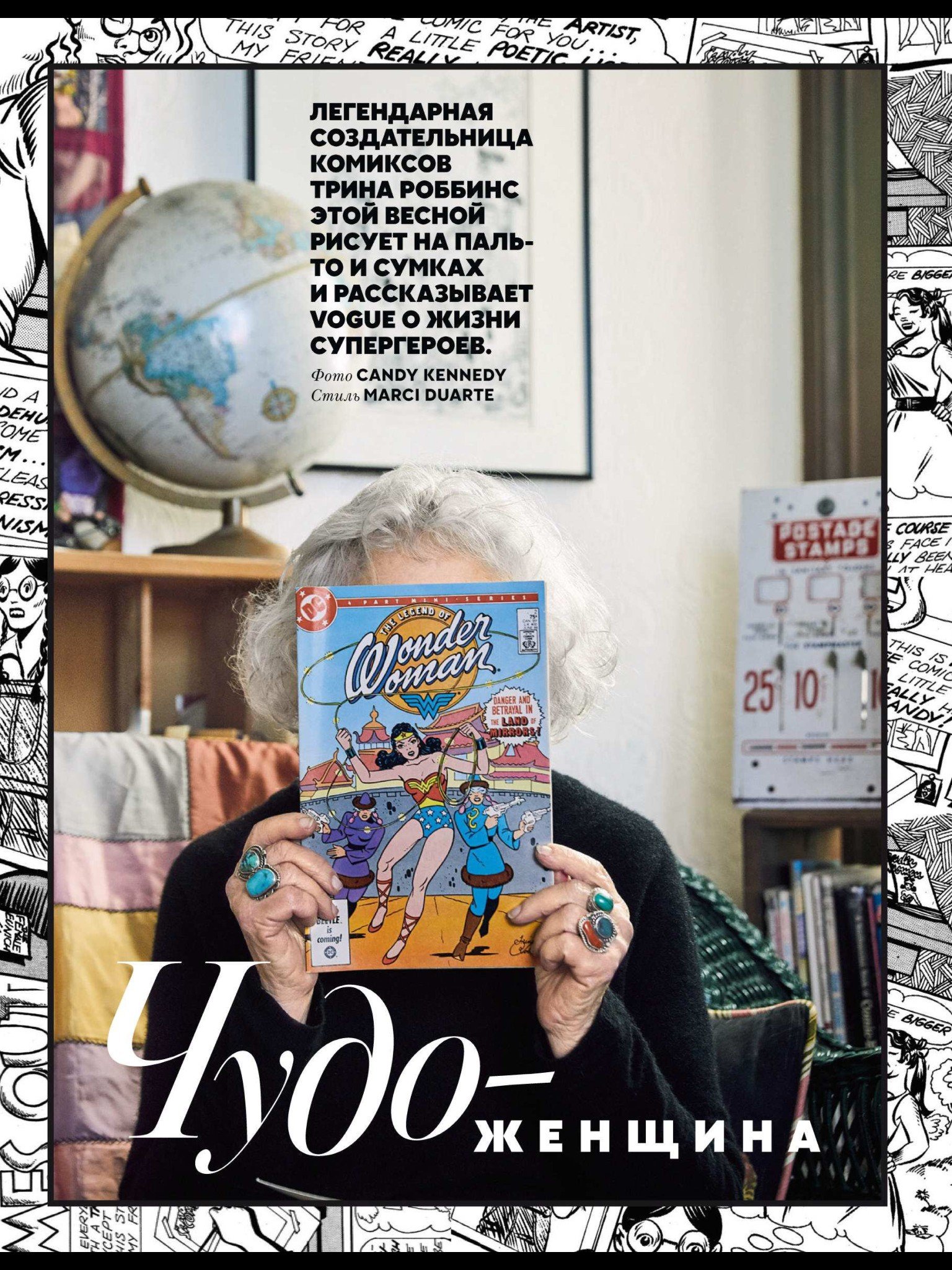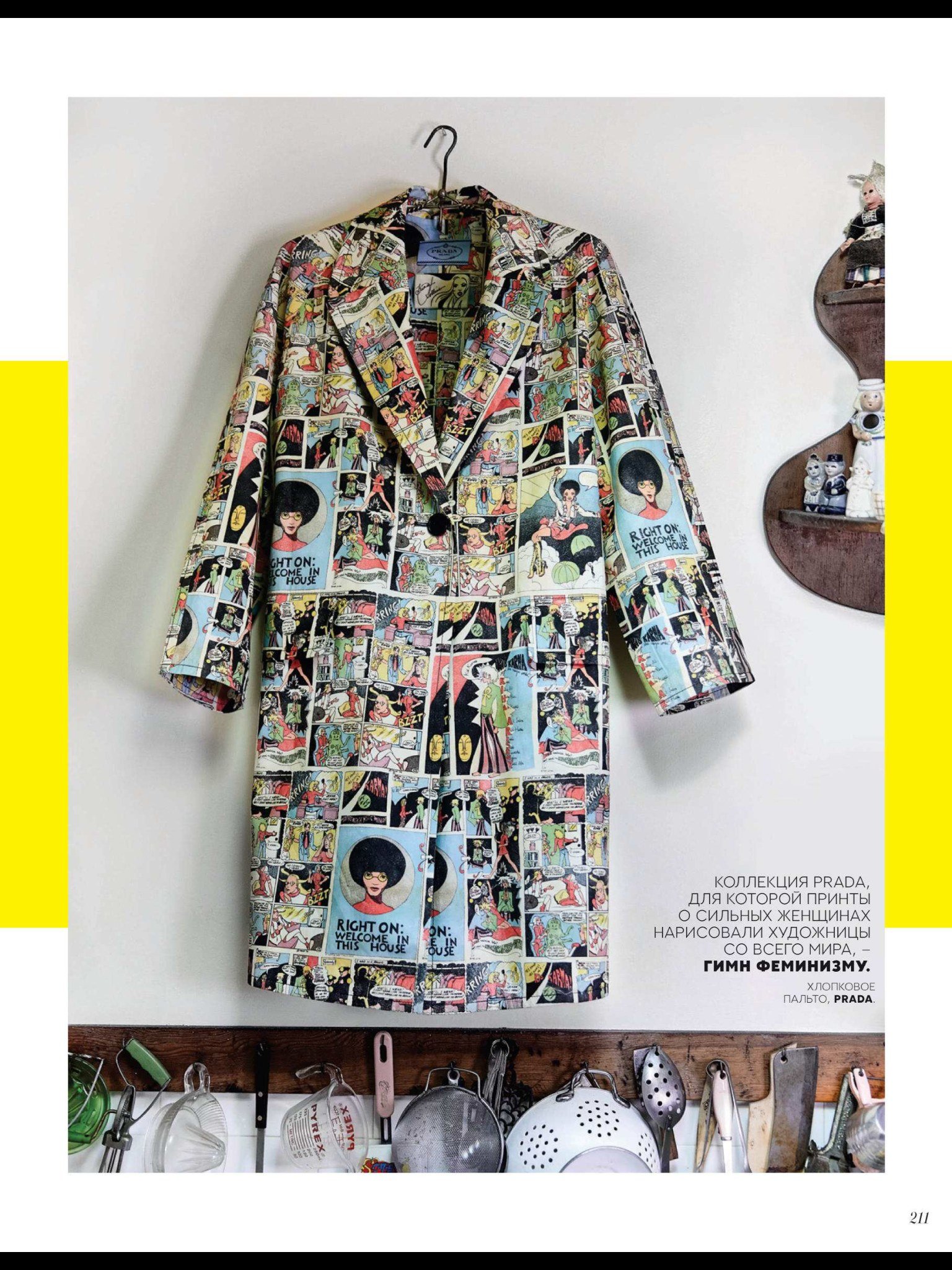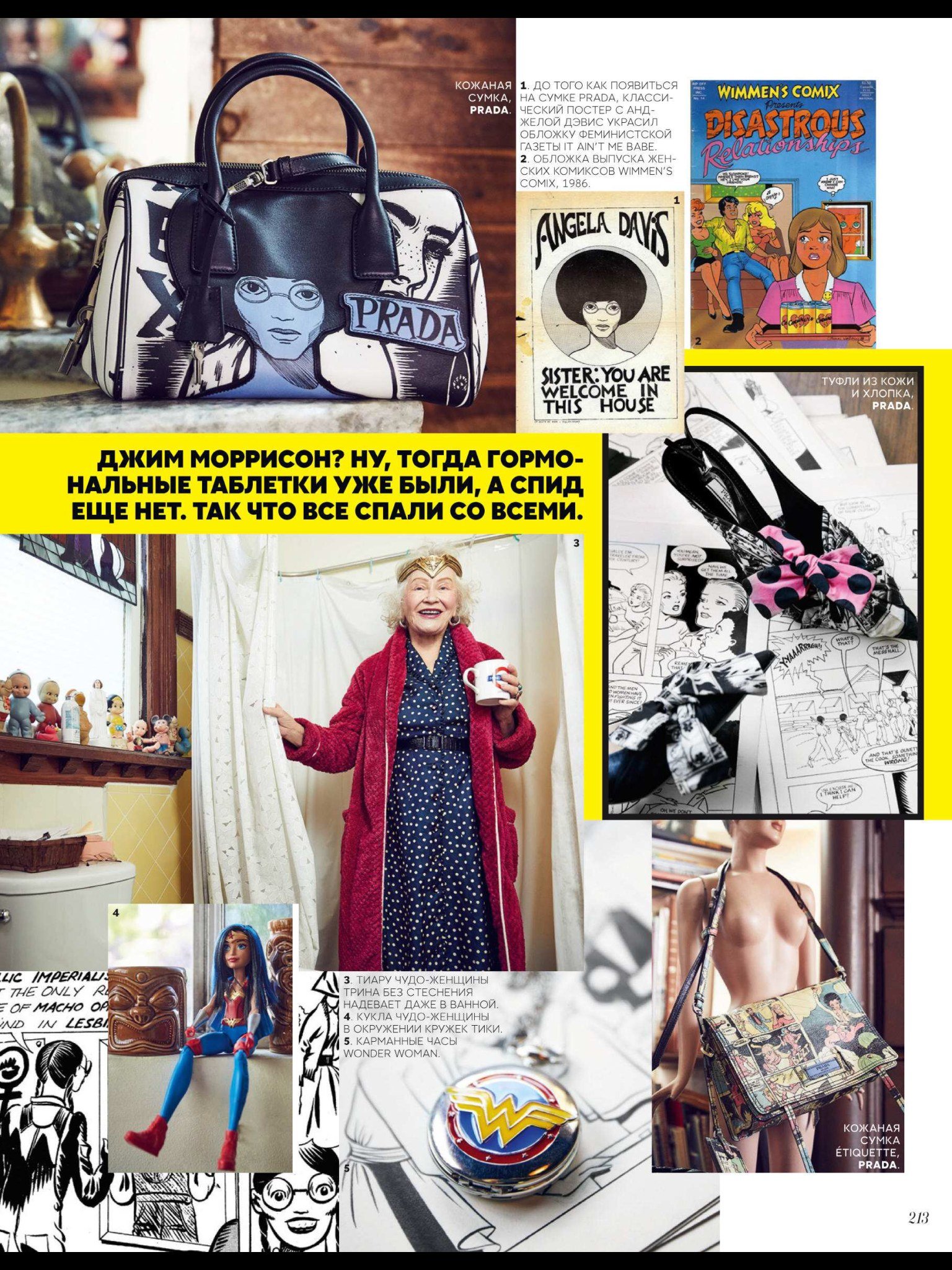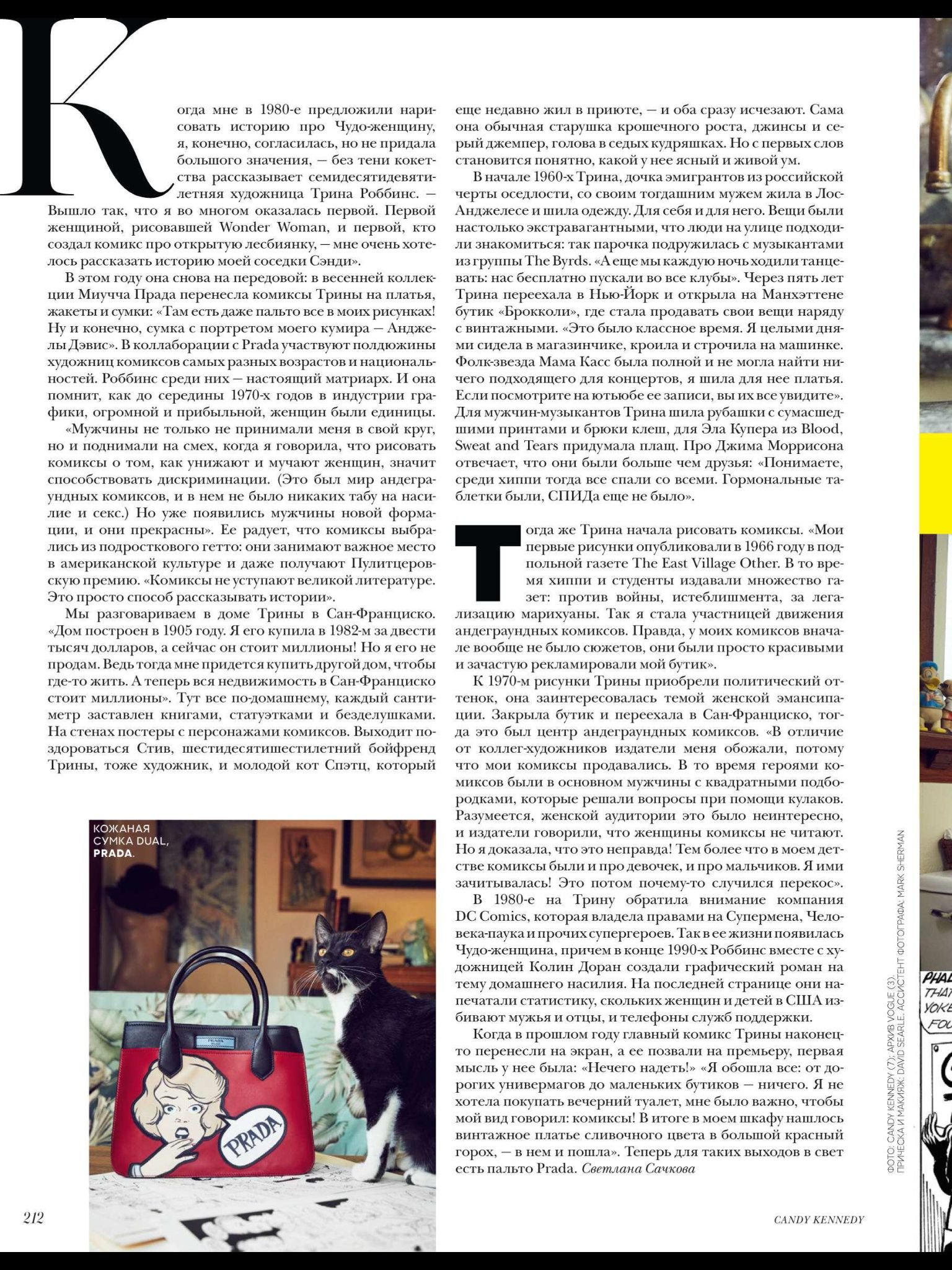Trina Robbins in Russian Vogue
/The comics community lost an icon yesterday, my friend and mentor Trina Robbins. I’ve read some 100+ interviews with her between the 1970s and the present over the last 6 months while I’ve been working on books on both Trina and Denis Kitchen for UPM’s Converversations series.
Trina strikes a pose as her 21st century woman (“Wimmen’s Comix” #8) in a 6/24/1984 article for a Connecticut newspaper fromoting “Women and the comics,” (with cat yronwode) an exhibit based on her first history of women cartoonists at the Museum of Cartoon Art.
Trina loved fashion her entire life. Before she became a cartoonist, she owned a store in New York where she designed and made clothes for rock stars of the ‘60s. She brought fashion into her own comics. She loved to hunt for vintage bargains and make her own clothes. One of her proudest moments was when Prada licensed some of her comics for a new line. This brought the attention of the fashion world back to Trina, including this article in Russian Vogue. I thank Jeff Trexler for pointing this out to me and his translation.
Wonder-Woman: Legendary comics creator Trina Robbins this spring draws on coats and bags and tells Vogue about the life of superheroes.
Photo: Candy Kennedy. Style: Marci Duarte. Text: Svetlana Sachkova.
“When in 1980 they asked me to depict the history of Wonder Woman, I, of course, agreed, but I did not give to it any big significance” — without a shadow of coquetry explains seventy-nine- year-old artist Trina Robbins. “It turned out that I was in many respects first. The first woman to draw Wonder Woman, and the first who created comics about an out lesbian — I very much wanted to tell the story of my neighbor Sandy.”
This year she is once again in the avant garde: in its spring collection Miuccia Prada transferred Trina’s comics to dresses, jackets, and bags. “There is even a coat entirely in my drawings! Well, and of course, a bag with a portrait of my idol — Angela Davis.” Half a dozen comic artists of different ages and nationalities are participating in the collaboration with Prada. Robbins among them — genuine matriarch. And she recalls how before the mid-70s in the large and profitable graphic industry women were few.
“Men not only did not accept me into their circle, but they also erupted into laughter when I said that drawing comics about how they humiliate and torture women is to promote discrimination. (It was the world of underground comics, and in it there were no taboos whatsoever about violence and sex.) But men of a new type have now appeared, and they are splendid. " She is glad that comics have gotten out of the adolescent ghetto: they occupy an important place in American culture and even receive the Pulitzer Prize. "Comics are not inferior to great literature. It's simply a means to tell stories. "
We're conversing in Trina’s house in San Francisco. “The house was built in 1905. I purchased it in 1982 for two hundred thousand dollars, and now it costs millions! But I'm not selling it. Then I’d have to buy another house to have somewhere to live, and now all the real estate in San Francisco costs millions. " Here it’s all homey; every centimeter is filled with books, statues and trinkets. On the walls are posters with comic book characters. Coming over to greet us are Steve, sixty-six-year-old boyfriend of Trina, also an artist, and a young cat, Spats, who not that long ago lived in a shelter - and both immediately disappear. She herself is an ordinary older woman of tiny stature, jeans and a gray jumper, head in gray curls. But from the first words it is evident how bright and lively is her mind.
In the early 1960s, Trina, the daughter of emigrants from Russia’s Pale of Settlement, lived with her then-husband in Los Angeles and sewed clothes. For herself and for him. The designs were so extravagant that people on the street approached to get acquainted: thus the couple made friends with musicians from the band The Byrds. "And so we went dancing every night: they let us into all clubs for free.” After five years Trina moved to New York and opened a boutique in Manhattan called “Broccoli,” where she began to sell her own designs along with vintage. “It was a wonderful time. I sat entire days in my little shop, cutting and stitching on a sewing machine. Folk star Mama Cass was large in size and not able to find anything suitable for concerts; I sewed dresses for her. If you look at her videos on YouTube you’ll see them all.” For male musicians Trina sewed shirts with crazy prints and bell-bottomed trousers; for Al Kooper of Blood, Sweat and Tears she designed a cloak. About Jim Morrison she answers that they were more than friends: “Among hippies back then, you understand, everyone slept with everyone. There were birth control pills; AIDS did not yet exist.”
It was then that Trina started to draw comics. “My first drawings were published in 1966 in the underground newspaper The East Village Other. At that time hippies and students published a lot of newspapers: against war, the establishment, for legalization of marijuana. So I became a participant in the underground comics movement. True, there generally weren’t any stories in my comics at first; they were simply attractive and often advertised my boutique.”
“Jim Morrison? Well, at the time birth control pills had already arrived but AIDS had not. Thus among hippies everyone slept with everyone.”
By 1970 Trina’s drawings took on a political hue, as she became interested in the theme of women’s liberation. She shuttered the boutique and moved to San Francisco, then the center of underground comics. “In contrast to my artist colleagues, publishers adored me, because my comics sold. At that time comic book heroes were mostly men with square chins who solved problems with the help of their fists. Of course, this was not interesting to a female audience, and publishers said that women do not read comics. But I proved that this is not true! Even more so in my childhood, comics were for both girls and boys. I read them! Then for some reason a shift occurred.”
In the 1980s, the DC Comics company, which held the rights to Superman, Spider-Man, and other heroes, turned its attention to Trina. Thus Wonder Woman appeared in her life, in connection with which in the late 1990s Robbins together with artist Colleen Doran created a graphic novel on the subject of domestic violence. On the last page they published statistics on how many women and children are beaten by husbands and fathers, along with phone numbers of support services.
When last year Trina’s main comic was transferred to the screen and they invited her to the premier, her first thought was “there’s nothing to wear!” “I went all around, from expensive department stores to small boutiques; nothing. I didn’t want to buy evening attire; it was important to me that my look said: comics! In the end, in my closet I found a vintage cream- colored dress with red polka dots — I went in it.” Now for such excursions into the spotlight there is a Prada coat.
Svetlana Sachkova






